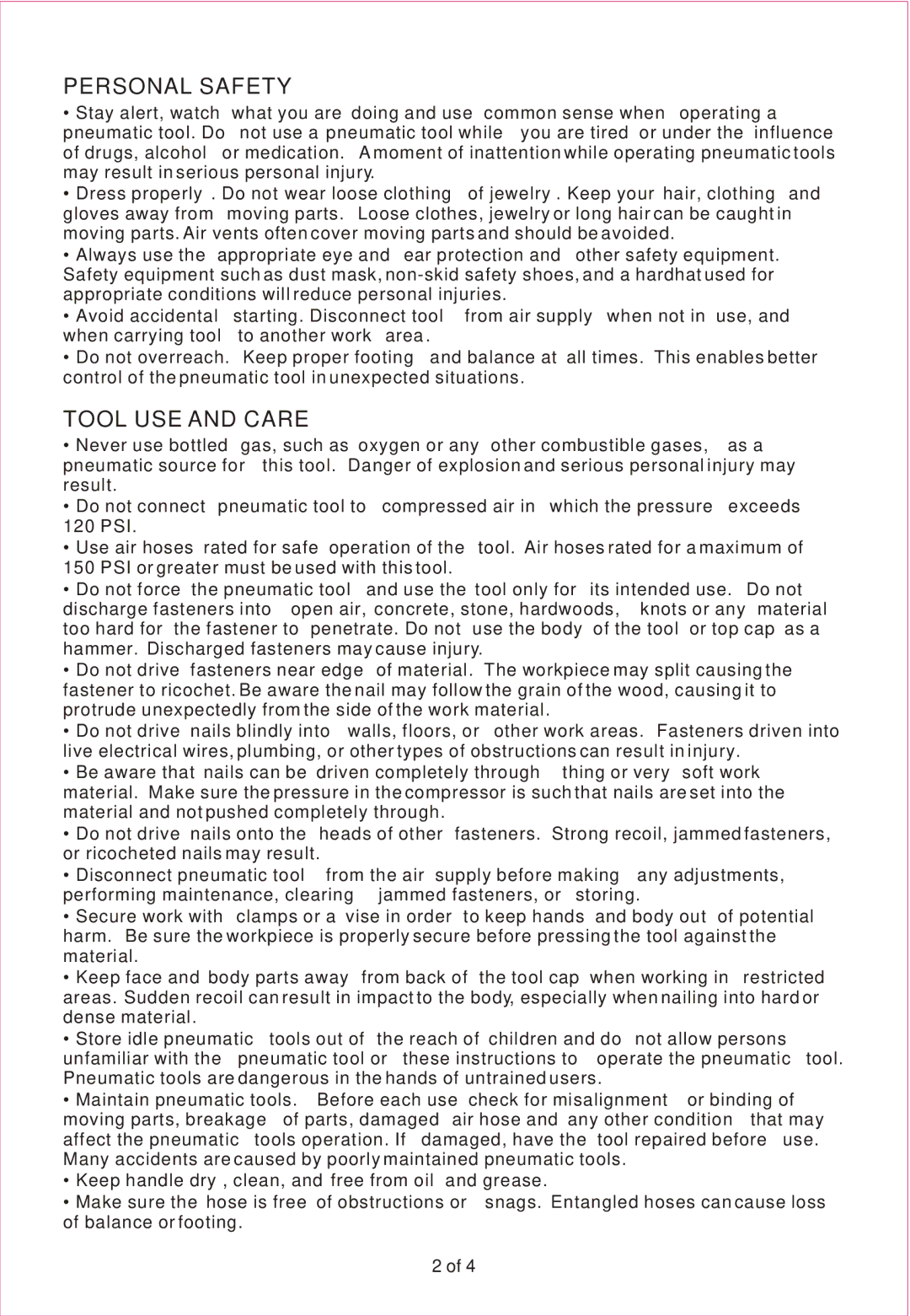
PERSONAL SAFETY
∙Stay alert, watch what you are doing and use common sense when operating a pneumatic tool. Do not use a pneumatic tool while you are tired or under the influence of drugs, alcohol or medication. A moment of inattention while operating pneumatic tools may result in serious personal injury.
∙Dress properly. Do not wear loose clothing of jewelry. Keep your hair, clothing and gloves away from moving parts. Loose clothes, jewelry or long hair can be caught in moving parts. Air vents often cover moving parts and should be avoided.
∙Always use the appropriate eye and ear protection and other safety equipment. Safety equipment such as dust mask,
∙Avoid accidental starting. Disconnect tool from air supply when not in use, and when carrying tool to another work area.
∙Do not overreach. Keep proper footing and balance at all times. This enables better control of the pneumatic tool in unexpected situations.
TOOL USE AND CARE
∙Never use bottled gas, such as oxygen or any other combustible gases, as a pneumatic source for this tool. Danger of explosion and serious personal injury may result.
∙Do not connect pneumatic tool to compressed air in which the pressure exceeds 120 PSI.
∙Use air hoses rated for safe operation of the tool. Air hoses rated for a maximum of 150 PSI or greater must be used with this tool.
∙Do not force the pneumatic tool and use the tool only for its intended use. Do not discharge fasteners into open air, concrete, stone, hardwoods, knots or any material too hard for the fastener to penetrate. Do not use the body of the tool or top cap as a hammer. Discharged fasteners may cause injury.
∙Do not drive fasteners near edge of material. The workpiece may split causing the fastener to ricochet. Be aware the nail may follow the grain of the wood, causing it to protrude unexpectedly from the side of the work material.
∙Do not drive nails blindly into walls, floors, or other work areas. Fasteners driven into live electrical wires, plumbing, or other types of obstructions can result in injury.
∙Be aware that nails can be driven completely through thing or very soft work material. Make sure the pressure in the compressor is such that nails are set into the material and not pushed completely through.
∙Do not drive nails onto the heads of other fasteners. Strong recoil, jammed fasteners, or ricocheted nails may result.
∙Disconnect pneumatic tool from the air supply before making any adjustments, performing maintenance, clearing jammed fasteners, or storing.
∙Secure work with clamps or a vise in order to keep hands and body out of potential harm. Be sure the workpiece is properly secure before pressing the tool against the material.
∙Keep face and body parts away from back of the tool cap when working in restricted areas. Sudden recoil can result in impact to the body, especially when nailing into hard or dense material.
∙Store idle pneumatic tools out of the reach of children and do not allow persons unfamiliar with the pneumatic tool or these instructions to operate the pneumatic tool. Pneumatic tools are dangerous in the hands of untrained users.
∙Maintain pneumatic tools. Before each use check for misalignment or binding of moving parts, breakage of parts, damaged air hose and any other condition that may affect the pneumatic tools operation. If damaged, have the tool repaired before use. Many accidents are caused by poorly maintained pneumatic tools.
∙Keep handle dry, clean, and free from oil and grease.
∙Make sure the hose is free of obstructions or snags. Entangled hoses can cause loss of balance or footing.
2 of 4
